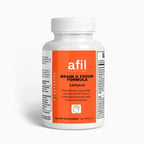Common Wheat Crops
Common wheat can cause gluten intolerance, allergies, or digestive issues. Avoid wheat, choose gluten-free options, and support recovery.
🌾 What Is Common Wheat?
Common wheat (Triticum aestivum) is a staple grain that can trigger sensitivities due to gluten, proteins, or cross-contamination.
🤔 Why Do I Have a Sensitivity to Common Wheat?
You may be sensitive to common wheat because:
-
Gluten intolerance – Wheat contains gluten, which can trigger immune or digestive reactions
-
Other wheat proteins – Compounds like amylase-trypsin inhibitors (ATIs) can cause inflammation even without gluten sensitivity
-
Cross-reactivity – If you're sensitive to other grains, your body may react similarly to wheat
-
Gut barrier issues – Wheat can contribute to leaky gut in some individuals, worsening symptoms
-
Existing allergies – Wheat allergy triggers immune responses different from gluten intolerance
🛠️ What Can I Do About It?
-
🚫 Avoid wheat-based foods—including bread, pasta, and baked goods
-
🌾 Choose gluten-free grains like rice, quinoa, and buckwheat
-
🍋 Support gut health with probiotics and gut-healing nutrients like L-glutamine
-
🛡️ Strengthen your immune system with anti-inflammatory foods and supplements
-
🌀 Watch for hidden wheat in sauces, soups, and processed foods
-
🥗 Focus on whole, minimally processed foods to reduce accidental exposure
💊 Which Supplements Can Help with a Common Wheat Sensitivity?
- Digestive enzymes (DPP-IV) – Aid in breaking down gluten for milder sensitivities.

- Probiotics – Support gut health and may reduce inflammation caused by wheat.

- Quercetin – A natural anti-inflammatory that may help with wheat allergy symptoms.

- Activated charcoal – May assist with detoxing after accidental wheat exposure.
- Vitamin D & zinc – Support immune function and gut lining repair for those with sensitivities.


🌟 How can I have a Reaction to Common Wheat When I Eat a Gluten Free Diet?
You might still react to common wheat even if you follow a gluten-free diet because:
-
Cross-contamination – Tiny traces of wheat can end up in “gluten-free” foods during processing, farming, or packaging
-
Non-gluten wheat proteins – Other compounds like wheat germ agglutinin (WGA) or amylase-trypsin inhibitors (ATIs) can trigger inflammation, even without gluten
-
Hidden wheat ingredients – Wheat-based additives (like modified food starch or flavorings) can sneak into processed foods
-
Sensitivity to grass-family plants – Your immune system might react to other components common in wheat and related grains
-
Existing gut or immune issues – A weakened gut barrier (leaky gut) can make you react to very small exposures that others might tolerate
🌾 Common Exposure Sources
- Bread, pasta, cereals, and baked goods
- Processed foods (soups, sauces, dressings, and snack bars)
- Beer, malt beverages, and some alcohols
- Cosmetics and skincare products with wheat derivatives
- Wheat-based pet foods or livestock feed
🍃 Alternatives (if tolerated)
- Gluten-free grains – Rice, quinoa, buckwheat, and millet.
- Nut and seed flours – Almond flour, coconut flour, and flaxseed meal.
- Certified gluten-free oats – If tolerated, as cross-contamination is common.
- Legume-based pasta – Chickpea, lentil, or black bean pasta.
.png?width=100&height=75&name=AFIL%20Logo%20(1).png)